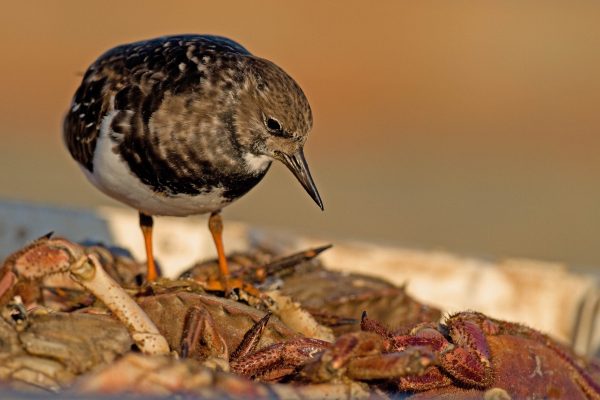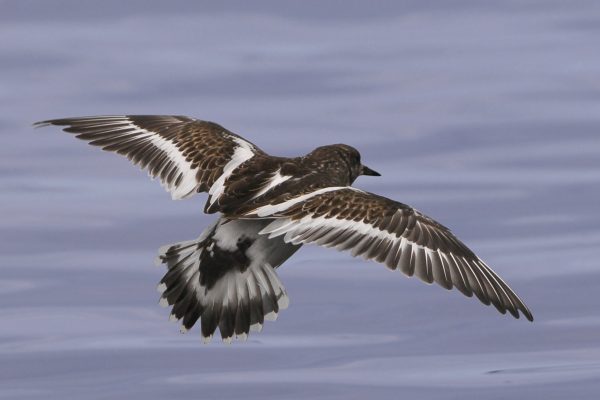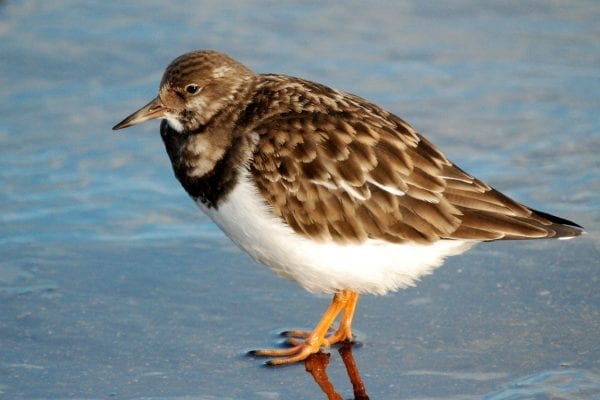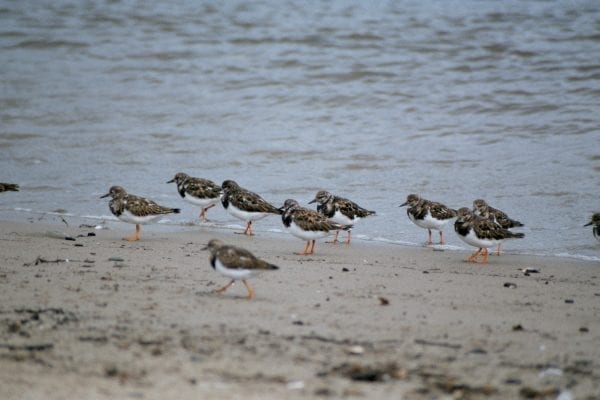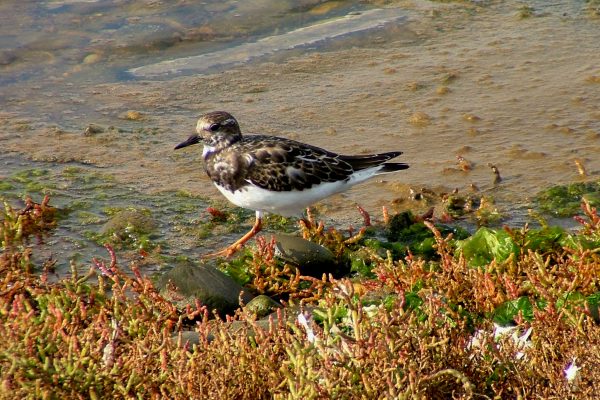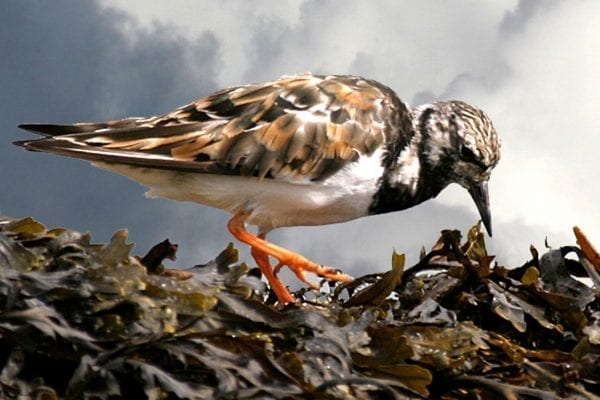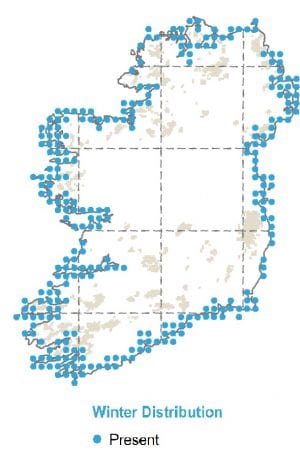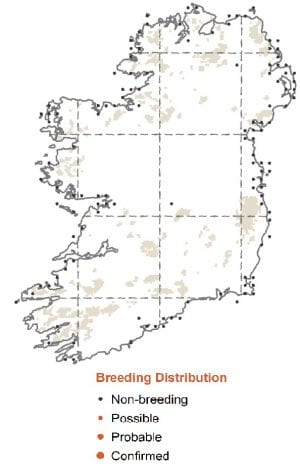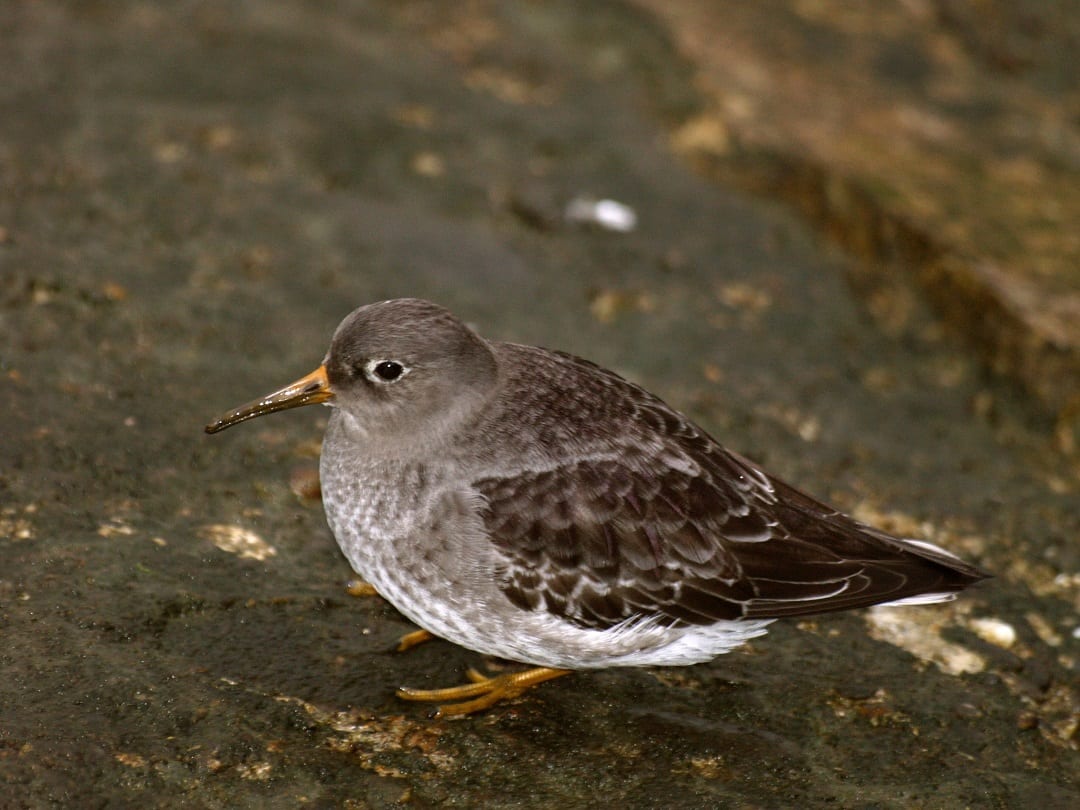
Turnstone
| Irish Name: | Piardálaí trá |
| Scientific name: | Arenaria interpres |
| Bird Family: | Waders |
amber
Conservation status
Conservation status
Status
Winter visitor from northeast Canada and northern Greenland, occurs late July to late April.
Identification
The wader most likely to be found along our rocky shoreline. Mainly a winter visitor, but good numbers pass through Ireland in spring and autumn en route to/from arctic and subarctic breeding grounds. About the size of a Starling, with a stocky build and short orange legs. In winter, its dark brown upperparts, white underside and black breast crescent make it difficult to see amongst seaweed. Spring birds are brighter and show rich chestnut markings on the wing and back. In flight, Turnstones show a series of black and white stripes, resembling a miniature Oystercatcher. Usually occurs in small flocks, moving with head down, constantly flicking over seaweed fronds, pebbles and beach debris with its short, stubby bill, in search of sand hoppers and other invertebrates.
Voice
Often calls in flight - an abrupt, loud, bubbly "tutt-tutt-tutt…".
Diet
Sandhoppers & other marine invertebrates. Also fish carrion washed up on shore.
Breeding
Does not breed in Ireland - breeding range all around shores of Scandinavia and Canada. Small numbers of non-breeding Turnstones (mainly first-summers) can be seen through the summer months.
Wintering
Winters all around the Irish coast.
Monitored by
Blog posts about this bird
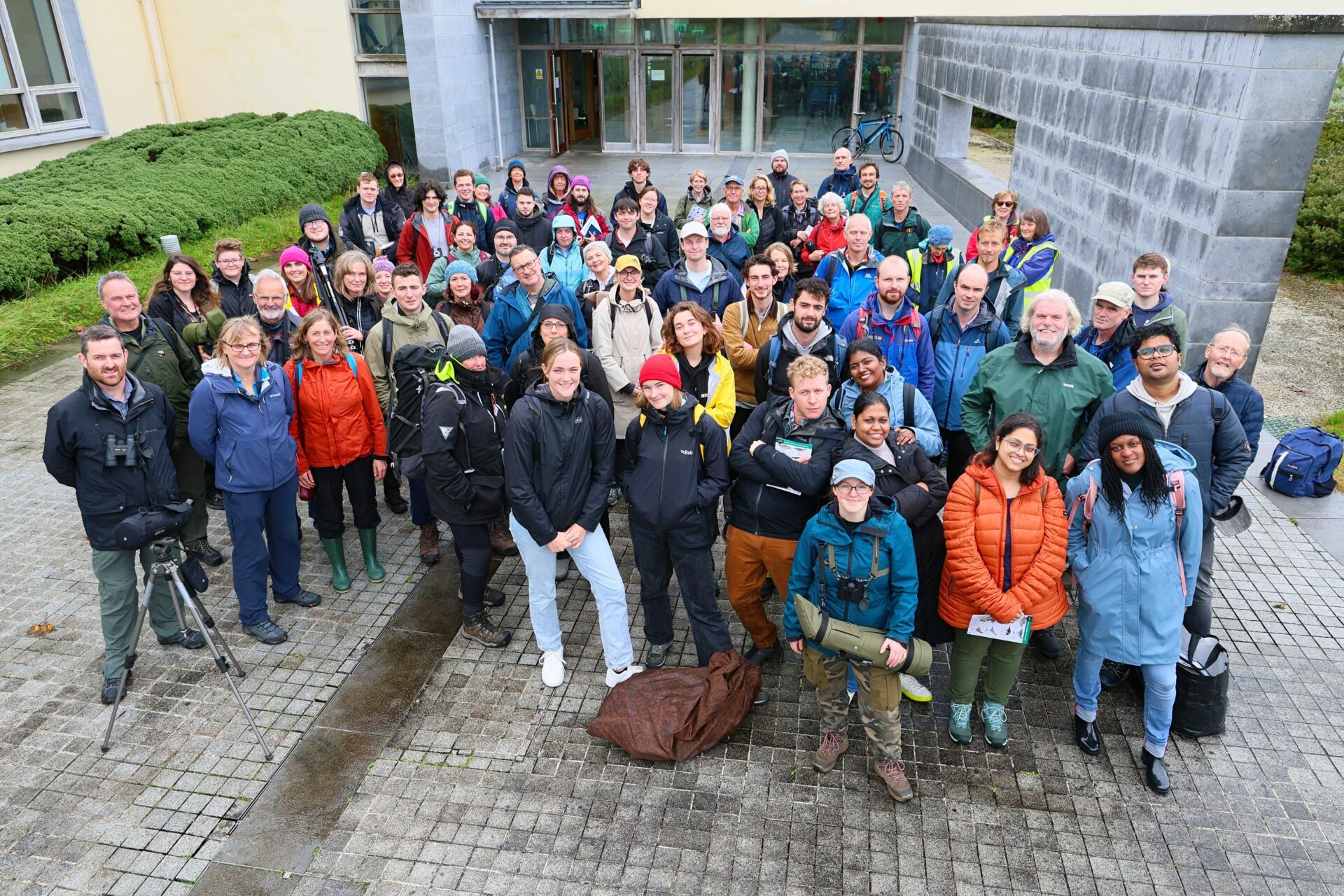
Record attendance at I-WeBS workshops highlights public appetite to support biodiversity
The high attendance at two recent introductory Irish Wetland Bird Survey (I-WeBS) workshops in Galway highlighted an increasing public desire to learn about and support biodiversity.
Organised by BirdWatch Ireland in collaboration with Galway County Council and Galway City Council with the support of the NPWS, the workshops were aimed at showing birdwatchers how they can help monitor wintering waterbird populations at Inner Galway Bay and in turn, inform their conservation. Additionally, BirdWatch Ireland also hoped to recruit new skilled I-WeBS observers to survey this important site during the 2023/ 24 season.
Over 120 people attended the workshops across the two days. The training days, which involved a combination of informative talks about the I-WeBS survey followed by an outdoor field method demonstration, were held on the 23rd September at Knocknacarra Community Centre and the 6th of October the Marine Institute. Within the talks, attendees found out about why it is so important to survey our wintering waterbirds as well as some hot tips for identifying and counting waterbirds. To pick up some tips and tricks for identifying waterbirds, take a look at the I-WeBS training tools.


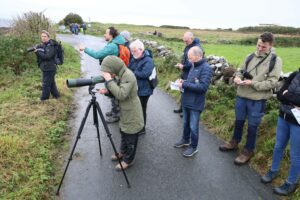
Workshop participants getting a glimpse of some interesting waterbirds at Rinville.
The outdoor portion of the events – which took place at Rusheen Bay and Rinville – proved fruitful, offering views of waterbirds such as Lapwing, Curlew, Turnstone and Sandwich Terns, to name but a few. Although not a waterbird, the sight of a beautiful female Wheatear hopping along the nearby rocks was a delightful bonus. Attendees brought with them a wealth of relevant experiences, skills and interests, with a high number of local university students and ecological consultants particular taking part. The interactive and informative workshops have thus far resulted in the recruitment of 30 new I-WeBS volunteers for Inner Galway Bay, with many more attendees choosing to sign up to survey at other sites. Meanwhile, the events inspired many more to get involved with their local Galway Branch of BirdWatch Ireland. In addition to boosting survey volunteer numbers, the recent events also offered a fantastic platform to spread the word about I-WeBS – a National Parks and Wildlife Service (NPWS) funded monitoring project that has been running since 1994. Every year between September and March, close to 500 I-WeBS volunteers record wintering waterbirds at important wetland sites around the country. Irish wetlands are extremely important for the survival of these birds and I-WeBS keeps track of how these birds are faring so that informed conservation action can be taken.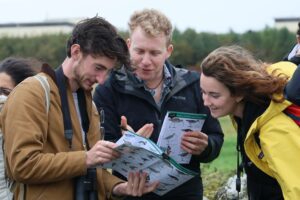
Participants working together to identify birds at Rinville.
The recent I-WeBS workshops focused predominantly on Inner Galway Bay – an internationally important site for wintering waterbirds, hosting over 20,000 birds every season. Inner Galway Bay is a site of international importance for the Great Northern Diver and Light-bellied Brent Goose, meaning that it regularly supports one per cent or more of the flyway population of these species. It is also a site of national importance for many birds, including Red-listed species such as Shoveler, Grey Plover, Dunlin, Redshank, Black-tailed Godwit, Bar-tailed Godwit and Lapwing. In all, the workshops proved to be a great success, in large part due to the strong collaboration between BirdWatch Ireland, BirdWatch Ireland’s Galway Branch, Galway County Council, Galway City Council, the Marine Institute and Knocknacarra Community Centre. BirdWatch Ireland is particularly grateful to Galway County Council and Galway City Council for funding binoculars and telescopes, which will be available for survey volunteers to rent from Galway City Library.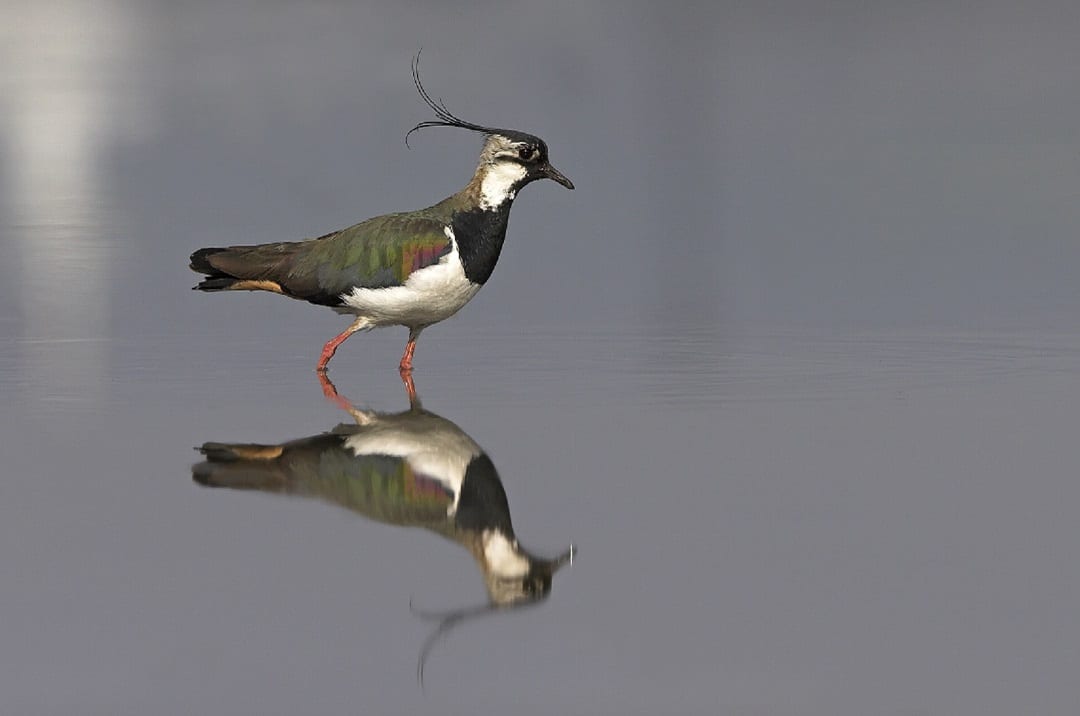
BirdWatch Ireland welcomes An Bord Pleanála decision on Boyne Greenway proposal
BirdWatch Ireland welcomes An Bord Pleanála’s decision to uphold the need to protect sites for threatened bird species by refusing to grant permission for a proposed new section of the Boyne Greenway.
The proposal for the construction of a pedestrian walkway and cycleway from Drogheda town to Mornington Village in County Meath was refused by An Bord Pleanála (ABP) at the end of August. In its report, ABP stated that it was not satisfied that the local authority has demonstrated beyond reasonable scientific doubt that the proposed development would not adversely affect the integrity of three protected sites – Boyne Coast and Estuary Special Area of Conservation (SAC), River Boyne and River Blackwater SAC and the Boyne Estuary Special Protection Area (SPA).
It noted that an absence of detailed information about a 2.4 km boardwalk proposed to be built inside the protected areas meant that avoiding adverse effects on these sites could not be guaranteed should the development go ahead. ABP also stated that it was not satisfied that important sand dune habitats would not be damaged by the greenway, nor that post-consent monitoring aimed at mitigating damage could be relied upon.
The impact of increased human activity along the Boyne Estuary and the risk of adverse impact that this could have on wintering waterbirds of the Boyne Estuary SPA was also noted, with ABP adding that it was not satisfied that proposed mitigation measures would be effective in preventing disturbance of these species.
This refusal and the reasons behind it are in line with concerns that have been raised by us since the project was initially put forward. We made our first submission to An Bord Pleanala regarding the greenway during the initial public consultation process in September 2020. While, as an environmental organisation, we welcome initiatives that reduce car usage and subsequently, greenhouse gas emissions, we objected to this development due to the significant threat to the bird life in the Boyne Estuary SPA.
With 2.4 km of the greenway proposed for construction within the boundary of the Boyne Estuary SAC and SPA and adjacent to the River Boyne and River Blackwater SAC, we had strong concerns about the threat of human disturbance and potential displacement this could cause to waterbirds in this area. From information provided by the developers, BirdWatch Ireland estimated that 210,000 new walkers including with dogs and cyclists would be using the boardwalk within the habitats for migratory waterbirds during the winter period when the birds are refuelling and resting before returning to Greenland, Iceland and the high Arctic to breed.
Migratory birds need access to safe roosting and feeding sites in order to rest and feed while overwintering in Ireland. However, disturbance from pedestrians, cyclists and dogs can cause birds to leave or completely avoid certain sites, leading to increased daily energy expenditure coupled with insufficient rest and fuel levels. This negatively impacts the ‘fitness’ of these birds (defined as the ability of an individual to survive, and breed and produce viable offspring, hence securing future generations of the species), so therefore can lead to population declines. As the frequency and duration of human activity on the proposed greenway would be high, there is no doubt that it would lead to disturbance to the bird life in the SPA.
BirdWatch Ireland made an additional submission in May 2022 following a request by ABP for further information from Meath County Council. On reviewing the additional information provided, we concluded that those proposing the project had not proved that disturbance caused by the greenway could be mitigated by their suggestions of screening and signage along the boardwalk.
Our submission was underpinned by Irish Wetland Bird Survey (I-WeBS) data showing both national and site-specific declines in the waterbird species listed for the Boyne Estuary SPA. Of the ten wintering waterbirds of special conservation interest listed for the Boyne Estuary SPA, half have a declining site status based on the long-term 23-year trend – Oystercatcher, Golden Plover, Grey Plover, Lapwing and Turnstone. The fact that these species are in decline at sites that are designated to provide a safe space for them underscores its unsuitability for a greenway. It further highlights the failures of the relevant authorities to manage existing activities that are causing deterioration of habitats and disturbance to waterbirds. The sand dune habitats, in particular, have undergone a great amount of damage due to a lack of management.
The overarching Conservation Objective for Boyne Estuary SPA “is to ensure that waterbird populations and their wetland habitats are maintained at, or restored to, favourable conservation condition”. We welcome the fact that, in this instance, this objective and threats posed by development to already vulnerable waterbirds have been acknowledged. However, looking forward, we believe there is a clear need for strategic guidance on greenway proposals, guidance which gives equal footing to biodiversity, climate and the needs of local residents. Not only would this approach prevent environmental damage, it would also reduce the amount of time and public money spent deliberating such proposals.
BirdWatch Ireland fully supports the development of greenways and initiatives that promote a modal shift in transport. These have obvious important benefits to climate but also economic and well-being benefits. However, it is vital that such developments do not come at a cost to our biodiversity, which is already experiencing pressures from all sides. In May 2019, Dáil Éireann declared a climate and a biodiversity emergency. Both must be addressed together.

